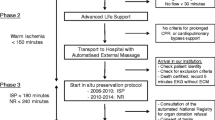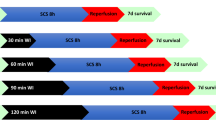Abstract
Background
Prolonged cold ischemia time (CIT) has been associated with inferior graft survival in kidney transplantation (KT). The aim of this study was to evaluate the impact of prolonged CIT on short- and long-term outcomes and to determine the possible ways to optimize the use of these organs.
Methods
All kidney transplants from April 2001 to December 2010 with CIT ≥ 20 h were considered. Donor and recipient data were analyzed with uni- and multivariate Cox proportional hazard analyses. Graft and patient survival were calculated using the Kaplan–Meier method.
Results
One hundred and eighty-one patients were transplanted with 184 grafts. Median recipient age and waiting time on dialysis were 52.5 and 4.9 years, respectively. After a median follow-up of 4.9 years, 148 of 181 patients are alive, 143 of them with functioning grafts. One-, three, and five-year graft and patient survival rates were 90, 87, and 79 %, and 96, 91, and 85 %, respectively. Donor age (p < 0.0001), retransplantation (p = 0.0025), and induction therapy with interleukin-2 antagonists (p = 0.0487) were predictors of graft survival by univariate analysis. Donor age and retransplantation remained significant by multivariate analysis (p < 0.001 and p = 0.0046, respectively). Donor age (p = 0.0176) and creatinine level at 1-month post-KT (p = 0.0271) were predictors of patient survival by univariate analysis. Only donor age reached multivariate significance (p = 0.0464). The calculated donor age cut off was 60 years.
Conclusions
Satisfactory long-term kidney transplant outcomes in the setting of CIT ≥ 20 h can be achieved with grafts from donors <60 years in first-time recipients. Induction therapy should preferably be with an interleukin-2 antagonist.


Similar content being viewed by others
Abbreviations
- CIT:
-
Cold ischemic time
- CMV:
-
Cytomegalovirus
- CPR:
-
Cardiopulmonary resuscitation
- DGF:
-
Delayed graft function
- HTK:
-
Histidine–Tryptophane–Ketoglutarate
- ICU:
-
Intensive care unit
- IGF:
-
Immediate graft function
- KLF2:
-
Krüppel–like factor 2
- KT:
-
Kidney transplantation
- ROC:
-
Receiver operating characteristic
- UW:
-
University of Wisconsin
References
Hernández D, Estupiñán S, Pérez G et al (2008) Impact of cold ischemia time on renal allograft outcome using kidneys from young donors. Transpl Int 21:955
Quiroga I, McShane P, Koo DD et al (2006) Major effects of delayed graft function and cold ischaemia time on renal allograft survival. Nephrol Dial Transpl 21:1689
Salahudeen AK, Haider N, May W (2004) Cold ischemia and the reduced long-term survival of cadaveric renal allografts. Kidney Int 65:713
Lee CM, Carter JT, Randall HB et al (2000) The effect of age and prolonged cold ischemia times on the national allocation of cadaveric renal allografts. J Surg Res 91:83
Bryan CF, Luger AM, Martinez J et al (2001) Cold ischemia time: an independent predictor of increased HLA class I antibody production after rejection of a primary cadaveric renal allograft. Transplantation 71:875
Mikhalski D, Wissing KM, Ghisdal L et al (2008) Cold ischemia is a major determinant of acute rejection and renal graft survival in the modern era of immunosuppression. Transplantation 85:S3
Lee CM, Carter JT, Alfrey EJ, Ascher NL, Roberts JP, Freise CE (2000) Prolonged cold ischemia time obviates the benefits of 0 HLA mismatches in renal transplantation. Arch Surg 135:1016
Opelz G, Döhler B (2007) Multicenter analysis of kidney preservation. Transplantation 83:247
Ciancio G, Gaynor JJ, Sageshima J et al (2012) Machine perfusion following static cold storage preservation in kidney transplantation: donor-matched pair analysis of the prognostic impact of longer pump time. Transpl Int 25:34
Gallinat A, Feldkamp T, Schaffer R et al (2011) Single-center experience with kidney transplantation using deceased donors older than 75 years. Transplantation 92:76
Goldsmith PJ, Ridgway DM, Pine JK et al (2010) Sequential transplant of paired kidneys following donation after cardiac death: impact of longer cold ischemia time on the second kidney on graft and patient outcome. Transpl Proc 42:3960
Pine JK, Goldsmith PJ, Ridgway DM et al (2010) Impact of cold ischemia on renal transplant outcomes following donation after cardiac death. Transpl Proc 42:3951
Johnston TD, Thacker LR, Jeon H, Lucas BA, Ranjan D (2004) Sensitivity of expanded-criteria donor kidneys to cold ischaemia time. Clin Transpl 18:S28
Jochmans I, Moers C, Smits JM et al (2010) Machine perfusion versus cold storage for the preservation of kidneys donated after cardiac death: a multicenter, randomized, controlled trial. Ann Surg 252:756
Treckmann J, Moers C, Smits JM et al (2011) Machine perfusion versus cold storage for preservation of kidneys from expanded criteria donors after brain death. Transpl Int 24:548
Lopes JA, Moreso F, Riera L et al (2005) Evaluation of pre-implantation kidney biopsies: comparison of Banff criteria to a morphometric approach. Kidney Int 67:1595
Burlingham WJ, Muñoz del Rio A, Lorentzen D et al (2010) HLA-A, -B, and -DR zero-mismatched kidneys shipped to the University of Wisconsin, Madison, 1993–2006: superior graft survival despite longer preservation time. Transplantation 90: 312
Kayler LK, Sokolich J, Magliocca J, Schold JD (2011) Import kidney transplants from nonmandatory share deceased donors: characteristics, distribution and outcomes. Am J Transpl 11:77
Bresnahan BA, Johnson CP, McIntosh MJ, Stablein D, Hariharan S (2002) A comparison between recipients receiving matched kidney and those receiving mismatched kidney from the same cadaver donor. Am J Transpl 2:366
Webster AC, Ruster LP, McGee R et al (2010) Interleukin 2 receptor antagonists for kidney transplant recipients. Cochrane Database Syst Rev (1):CD003897
Ekberg H, Tedesco-Silva H, Demirbas A et al (2007) Reduced exposure to calcineurin inhibitors in renal transplantation. N Engl J Med 357:2562
Hoeger S, Lueg G, Tsagogiorgas C et al (2011) UW is superior compared with HTK after prolonged preservation of renal grafts. J Surg Res 170:e149
Stewart ZA, Lonze BE, Warren DS et al (2009) Histidine-tryptophan-ketoglutarate (HTK) is associated with reduced graft survival of deceased donor kidney transplants. Am J Transpl 9:1048
Agarwal A, Murdock P, Fridell JA (2006) Comparison of histidine-tryptophan ketoglutarate solution and University of Wisconsin solution in prolonged cold preservation of kidney allografts. Transplantation 81:480
Moers C, Smits JM, Maathuis MH et al (2009) Machine perfusion or cold storage in deceased-donor kidney transplantation. N Engl J Med 360:7
Moers C, Jochmans I, Treckmann J et al (2011) Better graft survival with machine perfusion than cold storage after three years: follow up analysis of the European multicentre RCT in deceased-donor kidney transplantation. Transpl Int 24:S93
Gallinat A, Paul A, Efferz P et al (2012) Hypothermic reconditioning of porcine kidney grafts by short-term pre-implantation machine perfusion. Transplantation 93:787
Gracia-Sancho J, Villarreal G Jr, Zhang Y et al (2010) Flow cessation triggers endothelial dysfunction during organ cold storage conditions: strategies for pharmacologic intervention. Transplantation 90:142
Tullius SG, García-Cardeña G (2009) Organ procurement and perfusion before transplantation. N Engl J Med 360:78
Ciancio G, Gaynor JJ, Sageshima J et al (2010) Favorable outcomes with machine perfusion and longer pump times in kidney transplantation: a single-center, observational study. Transplantation 90:882
Conflict of interest
None.
Author information
Authors and Affiliations
Corresponding author
Rights and permissions
About this article
Cite this article
Gallinat, A., Paul, A., Minor, T. et al. Optimized outcomes for renal allografts with cold ischemic times of 20 h or greater. Int Urol Nephrol 44, 1417–1423 (2012). https://doi.org/10.1007/s11255-012-0235-8
Received:
Accepted:
Published:
Issue Date:
DOI: https://doi.org/10.1007/s11255-012-0235-8




